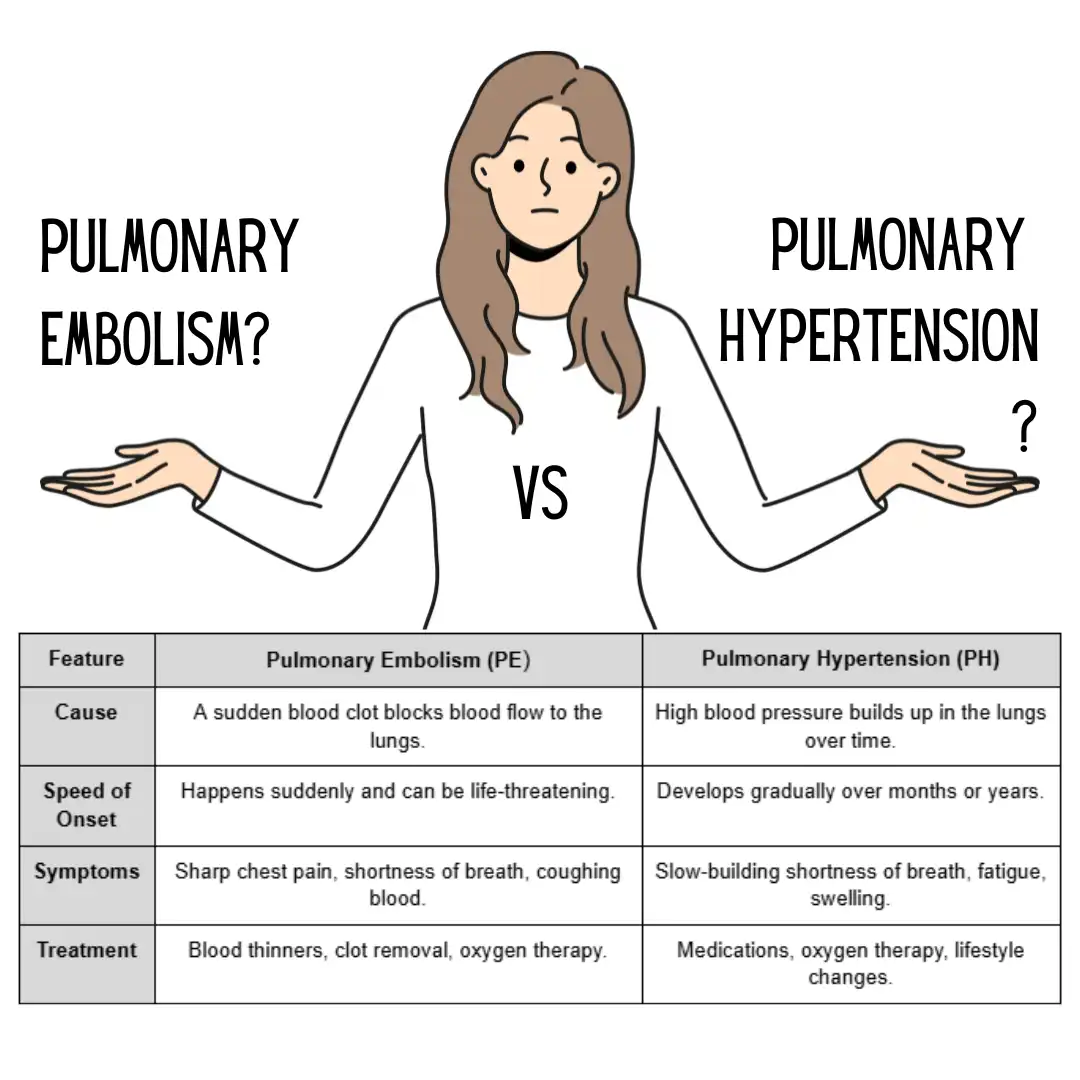Our lungs are like air filters for the body, making sure we get the oxygen we need. But sometimes, problems can happen with the blood flow in the lungs, leading to serious health conditions. Two such conditions are Pulmonary Embolism (PE) and Pulmonary Hypertension (PH). Although they might sound similar, they are very different. Let’s break it down.
What is Pulmonary Embolism (PE)?
Think of your blood vessels like water pipes. A pulmonary embolism (PE) happens when a blood clot blocks a pipe leading to the lungs. This stops blood from flowing properly, making it harder for your body to get oxygen. It usually happens when a clot forms in the leg and travels to the lungs.
What Causes It?
- Sitting too long – Like during long flights or being on bed rest after surgery.
- Certain health conditions – Heart disease, cancer, or blood clotting disorders.
- Hormonal changes – Pregnancy, birth control pills, or hormone therapy.
What Are the Symptoms?
- Sudden shortness of breath (like you can’t catch your breath)
- Sharp chest pain, especially when you breathe in
- Coughing (sometimes with blood)
- Fast heartbeat
- Feeling dizzy or fainting
How Is It Treated?
Doctors use:
- Blood thinners to stop new clots from forming.
- Clot-busting drugs in severe cases.
- Surgery or a catheter to remove large clots.
PE is a medical emergency that needs quick treatment!
What is Pulmonary Hypertension (PH)?
Pulmonary Hypertension (PH) is high blood pressure in the lungs. Unlike PE, which happens suddenly, PH develops slowly over time and puts extra pressure on the heart. This can make it harder for the heart to pump blood properly.
What Causes It?
There are different types of PH, but common causes include:
- Lung diseases like asthma or COPD.
- Heart conditions that affect blood flow.
- Blood clots that don’t fully clear out, leading to a rare condition called chronic thromboembolic pulmonary hypertension (CTEPH).
What Are the Symptoms?
- Feeling short of breath, especially when moving around
- Tiredness and weakness
- Swelling in the legs and ankles
- Chest pain or a racing heartbeat
- Bluish lips or skin (not enough oxygen in the blood)
How Is It Treated?
- Medications to relax the blood vessels in the lungs.
- Oxygen therapy for better breathing.
- Lifestyle changes like eating healthy and avoiding smoking.
- In severe cases, a lung or heart transplant may be needed.
Key Differences Between Pulmonary Embolism & Pulmonary Hypertension
| Feature | Pulmonary Embolism (PE) | Pulmonary Hypertension (PH) |
| Cause | A sudden blood clot blocks blood flow to the lungs. | High blood pressure builds up in the lungs over time. |
| Speed of Onset | Happens suddenly and can be life-threatening. | Develops gradually over months or years. |
| Symptoms | Sharp chest pain, shortness of breath, coughing blood. | Slow-building shortness of breath, fatigue, swelling. |
| Treatment | Blood thinners, clot removal, oxygen therapy. | Medications, oxygen therapy, lifestyle changes. |
Conclusion
While Pulmonary Embolism (PE) and Pulmonary Hypertension (PH) both affect the lungs, they are very different conditions.
- PE happens suddenly because of a blood clot and needs emergency treatment.
- PH develops over time and causes high blood pressure in the lungs, making it harder for the heart to work.
If you ever feel sudden chest pain, shortness of breath, or extreme tiredness that won’t go away, see a doctor right away! Early diagnosis and treatment can make a huge difference.

